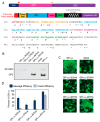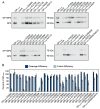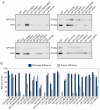Identification of Residues in Lassa Virus Glycoprotein Subunit 2 That Are Critical for Protein Function
- PMID: 30587764
- PMCID: PMC6471855
- DOI: 10.3390/pathogens8010001
Identification of Residues in Lassa Virus Glycoprotein Subunit 2 That Are Critical for Protein Function
Abstract
Lassa virus (LASV) is an Old World arenavirus, endemic to West Africa, capable of causing hemorrhagic fever. Currently, there are no approved vaccines or effective antivirals for LASV. However, thorough understanding of the LASV glycoprotein and entry into host cells could accelerate therapeutic design. LASV entry is a two-step process involving the viral glycoprotein (GP). First, the GP subunit 1 (GP1) binds to the cell surface receptor and the viral particle is engulfed into an endosome. Next, the drop in pH triggers GP rearrangements, which ultimately leads to the GP subunit 2 (GP2) forming a six-helix-bundle (6HB). The process of GP2 forming 6HB fuses the lysosomal membrane with the LASV envelope, allowing the LASV genome to enter the host cell. The aim of this study was to identify residues in GP2 that are crucial for LASV entry. To achieve this, we performed alanine scanning mutagenesis on GP2 residues. We tested these mutant GPs for efficient GP1-GP2 cleavage, cell-to-cell membrane fusion, and transduction into cells expressing α-dystroglycan and secondary LASV receptors. In total, we identified seven GP2 mutants that were cleaved efficiently but were unable to effectively transduce cells: GP-L280A, GP-L285A/I286A, GP-I323A, GP-L394A, GP-I403A, GP-L415A, and GP-R422A. Therefore, the data suggest these residues are critical for GP2 function in LASV entry.
Keywords: Lassa virus; arenavirus; fusion protein; viral entry; viral fusion; viral glycoprotein.
Conflict of interest statement
The authors declare no conflict of interest.
Figures





Similar articles
-
Biological Characterization of Conserved Residues within the Cytoplasmic Tail of the Pichinde Arenaviral Glycoprotein Subunit 2 (GP2).J Virol. 2019 Oct 29;93(22):e01277-19. doi: 10.1128/JVI.01277-19. Print 2019 Nov 15. J Virol. 2019. PMID: 31462569 Free PMC article.
-
Mutational Analysis of Lassa Virus Glycoprotein Highlights Regions Required for Alpha-Dystroglycan Utilization.J Virol. 2017 Aug 24;91(18):e00574-17. doi: 10.1128/JVI.00574-17. Print 2017 Sep 15. J Virol. 2017. PMID: 28679759 Free PMC article.
-
Lamp1 Increases the Efficiency of Lassa Virus Infection by Promoting Fusion in Less Acidic Endosomal Compartments.mBio. 2018 Jan 2;9(1):e01818-17. doi: 10.1128/mBio.01818-17. mBio. 2018. PMID: 29295909 Free PMC article.
-
Lassa virus glycoprotein complex review: insights into its unique fusion machinery.Biosci Rep. 2022 Feb 25;42(2):BSR20211930. doi: 10.1042/BSR20211930. Biosci Rep. 2022. PMID: 35088070 Free PMC article. Review.
-
Inter-Lineage Variation of Lassa Virus Glycoprotein Epitopes: A Challenge to Lassa Virus Vaccine Development.Viruses. 2020 Mar 31;12(4):386. doi: 10.3390/v12040386. Viruses. 2020. PMID: 32244402 Free PMC article. Review.
Cited by
-
SARS-CoV-2 Spike Alterations Enhance Pseudoparticle Titers and Replication-Competent VSV-SARS-CoV-2 Virus.Viruses. 2020 Dec 18;12(12):1465. doi: 10.3390/v12121465. Viruses. 2020. PMID: 33353101 Free PMC article.
-
Construction and Immunological Evaluation of an Adenoviral Vector-Based Vaccine Candidate for Lassa Fever.Viruses. 2021 Mar 15;13(3):484. doi: 10.3390/v13030484. Viruses. 2021. PMID: 33804206 Free PMC article.
-
Ebola Virus Requires Phosphatidylserine Scrambling Activity for Efficient Budding and Optimal Infectivity.J Virol. 2021 Sep 27;95(20):e0116521. doi: 10.1128/JVI.01165-21. Epub 2021 Jul 28. J Virol. 2021. PMID: 34319156 Free PMC article.
-
Characterizing the Lassa Virus Envelope Glycoprotein Membrane Proximal External Region for Its Role in Fusogenicity.Virol Sin. 2021 Apr;36(2):273-280. doi: 10.1007/s12250-020-00286-3. Epub 2020 Sep 8. Virol Sin. 2021. PMID: 32897505 Free PMC article.
-
Perspectives on the Use of Small Noncoding RNAs as a Therapy for Severe Virus-Induced Disease Manifestations and Late Complications.Bionanoscience. 2022;12(3):994-1001. doi: 10.1007/s12668-022-00977-z. Epub 2022 May 4. Bionanoscience. 2022. PMID: 35529531 Free PMC article. Review.
References
-
- Ogbu O., Ajuluchukwu E., Uneke C.J. Lassa fever in West African sub-region: An overview. J. Vector Borne Dis. 2007;44:1–11. - PubMed
-
- Lassa Fever—Nigeria. [(accessed on 2 July 2018)]; Available online: http://www.who.int/csr/don/20-april-2018-lassa-fever-nigeria/en/
Grants and funding
LinkOut - more resources
Full Text Sources
Research Materials

